The genre of chamberlarps, in the meaning of larps playable in 1-2 rooms, have changed dramaticly during the past five years. In this blogpost, based on my key note at the Knudepunkt conference, I will try go give an historical overview of what has changes, what this means and a few predictions for the future. I have included a few examples from before 2010, larps that I believe have been influential to late design. However, the main focus in this article is on what has happened the last five years.
Early years of chamberlarps
Many years ago, I heard rumours of this strange Finnish larp with a lot of flour and half-naked people in a green room. In the mid-2000, I was impressed that «New voices in art» took larp into an arts festival, but after what I heard, it was quite different from what I considered normal larps. In the late 2000s, the czechs were developing black box larps for a wide audience, but I didn’t know about that.
This year, Week-in Denmark was kicked off by Black box Horsens, where lots of people from all over the world came to Horsens, four hours from Copenhagen, to play black box larps. At Knutepunkt, there was a track dedicated to Black box larps. In Norway last year, around half of the larps organized, and nearly all of the chamberlarps were black box larps. How did we get here?
It’s a little more than four years since the Nordic Larp book came out. Still before the Chamberlarp Revolution, the book featured mostly large-scale productions of longer duration. However, a few early predecessors of the modern chamberlaprs were included, notably inside:outside and Luminesence – which is not just being naked and weird in a green room, but a strong larp about being a cancer patient.
In his discussion in the same book on whether larp is art, Jakko Stenros notes “Larps are sporadically invited to join art festivals, but it is rare that larps not created with an institutionalized art world in mind would make their way to galleries and museums. Whether these tailored larps will develop into a subgenre of «art gallery» larps remain to be seen”.
I’d say that this discreete prediction is now closer than ever to become a reality as the sub-genre is emerging in the name of black box larps. But despite inside:outside in 2001 and Luminescence in 2004 it took many more years for the energy of the Chamberlarp Revolution to be unleashed.
By the end of the first decade in the 2000s, the Jeepen movement had already done a great deal to bring the Fastaval / freeform tradition closer to the larp community.
Then, in 2009-2010 there was a surge in the creation of Tape Larps. Inspired by the movie Dogville, larp designers started to use tape on the floor to make walls. This made inexpensive larps with great venue flexibility and also introduced a very aggressive transparancy.
Networks and festivals
At the same time, new opportunities opened for where to play these larps. Prolog in Västerås and the Larp Factory in Oslo were the first of several networks and conventions that now make up the backbone of chamberlarp production in the Nordic countries.
Prolog was offering black boxes which for many larpwrights had been hard to access, and quickly became a catalyst at getting people to write chamber larps. But the impact was not only on the quantity of larps being written. The festival also introduced a 4 hour time limit, but most important was how Prolog influenced the scene by offering high quality technical equipment for theatre lighting, which of course the jeepers and other tape larp designers could not resist using when it was available.
The Larp Factory was a network aiming to make short larps easily accessible to a wider audience. It kicked off with the Jeepform scenario «The Upgrade» in june 2009, and organized a larp every month until the end of 2012. The idea also spread to several other cities and led to a surge in the creation and production of short larps. However, after the first year of running, the Larp Factory in Oslo had hosted monthly chamberlarps, but still not a single black box larp.
During the fall of 2010, an event with the tagline «From Sweden with Tape» was planned in Oslo, and a handfull of Swedish larp designers were invited to run their «tape larps». This event is what we now know as Grenselandet. With Grenselandet, nordic chamberlarp designers got a second venue where black boxes were made available. Grenselandet also followed up Prolog’s 4-hour rule.
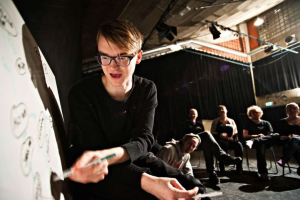
When our destinies meet at Grenselandet. Photo: Skjag Vold. Larp credit: Morgan Jarl and Petter Karlsson.
The festival format however also demanded larps that were playable for players who came entirely unprepared. The pre-larp workshop gradually went from being a short supplement to what the players had prepared at home, to being an integrated part of the the larp design that could often take up more time than the larp itself.
The giants
But festivals were not the only place interesting stuff happened. 2010 and 2011 also saw two large black box larps, Delirium and Kapo.
While often not considered chamberlarp because they are much larger in terms of participants, duration and production scale, these two larps have been very important to the chamberlarp tradition. They were played in a black box, they actively use lights, sounds and props, they are quite physical and they rely on workshops.
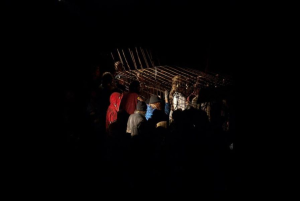
Kapo. Photo: Peter Munthe-Kaas. Anders Berner, Jakob Hedegaard, Kim Holm, Juliane Mikkelsen, Peter Munthe-Kaas, Frederik Nylev, Rasmus Petersen
Kapo, with 180 players, showcased these techniques to a broader player base as well as to spectators.
Concequences of the black box
Moving the larps from scenario specific locations and into black boxes also opened doors to more traditional houses of art. An example: In 2010 the Baader-Meinhof Experiment, a larp originally written for two specific apartments in Oslo, was redesigned to run in the theatre black box of Riksteatern in Stockholm.
However, it was in 2012 the Chamberlarp Revolution really gained momentum.
A small festival called Black Box Copenhagen put up five scenarios at Huset. To foster experimentation, the festival did not require any manuscript to be written, and did not have any competition or prizes. The only criteria was that the larps should actively use at least two of the following four tools in the design:
- lights
- sound
- props
- audience
I’d say that Blackbox Copenhagen was fundamental in defining the genre of Black box larps as we know if today. The festival was repeated only six months after the first run.
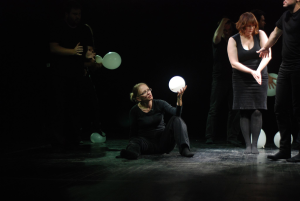
White Death at Blackbox cph. Photo: Jesper Heebøll Arbjørn. Larp credit: Nina Runa Essendrop and Simon Steen Hansen.
This was the premiere for White Death, which is probably the most influential chamberlarp in recent years. While early art chamberlarps such as Luminiscence also had experimented with language restrictions, White Death went further, abolishing all verbal communication. This is a design choice that has since been replicated with success in several larps such as Temple of the blind beings, The Heist and Life on a string.
Spreading the gospel
2012 was also the year of the first Larpwriter Summer School. This is a weeklong intensive course in larp design (It’s still open for applictions, check it out).
Through the follow-up event The Larporatory and also the Larp Exchange Academy in 2013, first-time larp designers created numerous larps that have most of the hallmarks of modern chamberlarps design. Maybe some of you tried out Stereo Hearts, The last hour or Have you come here to play Jesus during Week-in Denmark.
The Larpwriter summer school application lists also gives us an indication that artists from other genres of art, in particular performance, have started getting more interested in what we do.
But it was as late as 2013 when the documentation of chamberlarps finally changed. While the freeform tradition had a long history of writing down scenarios, the chamberlarps tradition, with a few exceptions, hardly even had reruns.
With the publication of Larps from the Factory, a book with 23 larp scripts from the Larp Factory, the chamberlarp world’s eyes were opened to the value of manuscripts.
The same year, Stockholm Scenario festival was established, making it a requirement for all larps to be run there to have a written script, further contributing to spreading the gospel all over the world.
The format of black box larp has gotten foothold in many countries. In the Netherlands, a country that was mostly absent in the scene of Nordic larp just 3-4 years ago, several of the contributions to the 1st and 2nd Dutch larpwriter challenge are larps that rely heavily on pre-larp workshops, physical communication and many of them are designed to play in black boxes.
Art larps – larps for the people?
As mentioned, black box chamberlarps was the most frequently played format in Norway last year. Of course, this has to do with accesibility in terms of venue and duration, but I also believe closer affiliation to other art scenes means that they format appears more open.
In Oslo, Blackbox Deichman is a network that runs larps at a library every month. It usually recruits a handful of newcomers each time, but in January at least 15 new faces showed up (This is a lot in Norway).
We had the British performance artist Adam James come to run his larp I Know You Are But What Am I (created at the Larporatory). The information of this event spread in performance circles, and was probably the reason for all the new faces. Unfortunately, some of them left when they realized they had to play themselves, but others overcome the fear and stayed.
Just this is one of the main challenges for chamberlarps, both in terms of recruitment, and in terms of acceptance as art: How to design better for more people to overcome the fear and eable them to play.
Ebba Petren presented some approaches to overcome this fear during Nordic larp talks, including using using headphone instructions to enable an audience to take part in an interactive experience.
There are also examples of larp that allows players to go directly in and play with no preparation workshop, such as Temple of the blind beings or Inside myself Outside myself.
A list of 10 trends
|
2010 |
2015 |
|
|
Venue |
Scenario specific |
Black box |
|
Organizer instructions |
Designer’s own notes |
Manuscript |
|
Player preparations |
Before arriving at the larp venue |
Meet up and play (workshop) |
|
Workshop/play ratio |
More play |
More workshop |
|
Duration |
2-12 hours |
2-4 hours |
|
Communication |
Mostly verbal |
Verbal and physical |
|
Costume |
Scenario specific |
Come as you are/ |
|
Light effects |
Rarely |
Yes |
|
Sound effects |
Rarely |
Yes |
|
Casting |
Yes |
No |
- To sum up, the chamberlarps have moved out of the scenario specific locations and into the black box.
- We no longer rely only on the creator(s)’ personal notes, there are manuscripts being written out.
- Players are not expected to prepare characters or costumes before they arrive, all preparations are made on the spot, under the facilitation of the organizers.
- The time spent on workshops have relatively increased on the expense of the time used to play.
- The larps are getting shorter, usually 2-4 hours, to fit into the requirements of most festivals. Blackbox Copenhagen has longer slots, but larps from here that’s being rerun at other festivals are often shortened down to 4 hours.
- More larps rely on physical communication, while verbal communication was the champion five years ago.
- Few larps use costumes, you can come as you are or play in just a black shirt. If costumes are used at all, they are increasingly often provided by the organizer(s).
- Light and sound effects are the rule of thumb in modern chamberlarp design, while this used to be something only occasionally used.
- And with player preparations being replaced by workshops, it also means the casting process goes out of the window in most cases.
I believe the most important of all these developments is change of venues – in many ways a prerequisite for the other developments. I’d like to share an anecdote that I think really proves the strengt of the black box. At the Larporatory in Vilnius last month, one group of first-time larp designers had made a larp called «Bring your own bottle». It’s about four friends that have that meet in a bar to get drunk one last time before they all will quit drinking. I offered the organizers of this larp to play it in a real bar with no other people present. Even though we had access to this venue, they still preferred a black box – to enable universal design with full control over the lights and scenography.
It can be argued that it’s risky that not everyone have access to black boxes. I don’t agree with this. Just because Prolog have professional equipment doesn’t mean you can’t play in any black room. Here’s a picture from the blog of the Latvian larper Gints on how to turn any room into a black box
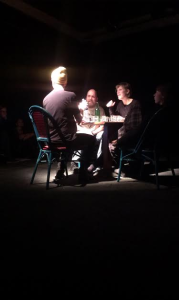
Bring your own bottle. Photo: Martin Nielsen. Larp credit: Nastassia Sinitsyna, Yauheniya Siadova, Alisa Matavilava
.
Concequences of the chamberlarp revolution
1. Accessibility. The Chamberlarp Revolution means that we have made chamberlarps more accessible the last five year.They are more flexible, easier to rerun, and more approachable by all kinds of people.
2. Acknowledgement. The chamberlarps are getting more acknowledged. Our festivals move out of classrooms and scenario specific locations and into culture houses. Artists of other genres paying attentions to larps are still not many, but the number is increasing, and it’s not just artists with larper background, people go the other way too.
3. Identity. Larp designers we have become workshop designers. We still design story, characters, scenography and so forth, but the most important part of the chamberlarp is the workshop. The workshop is no longer an seperate add-on, it is an integrated an inseperable part of the design of a modern chamberlarp. I think perhaps in a few years we will not talk so much about workshops, but that is not because they will be less important, it’s rather because it will be even closer integrated with the rest of the design. At least when we talk about larps trying to create an easily accessible art experience such as Inside myself outside myself, they are formally without at workshop, but in reality its just that the workshop is integrated into the rest of the experience.
The future
What does all this mean for the future? I have four predictions and two wishes for the future:
- We will continue to make larps even more accessible, by integrating workshop techniques in the design in a way that will help more people overcome the anxiety of participating.
- We will make even shorter formats to permit more people to play. Just like short key notes or formats like pecha kucha are gaining popularity on the expense of long talks, we will find even shorter larp formats. Tabletop roleplayers have «roleplaying poems» that can be played in 15 minutes. I don’t know how, but I’m sure we will also have an eqvivialent in larp.
- Manuscripts will be attributed to author rights, that will provide royalities, which will make one more stepping stone in making it possible to live professionally from larps.
- And larps will start adapting other larps. In his Nordic Larp talk, Evan Torner spoke about adaption litterature or films into, but we will also see, just as in the theatre, that reruns will use LARP manuscripts but use their own adaptions, such as changing the setting but keeping the story.
And the hopes:
- I really hope Finland will get back in the game. With so much tradition for one day larps, and with important works such as Luminicsence in the back log, I really believe this country has a large potential to contribute more to the modern chamberlarps. But I also believe new Finnish venues are neccesary to accelerate this.
- And finally I hope that someone will pick up the tradition from Mellam Himmel och Hav, Delirium and not least Kapo and make another giant black box larp.
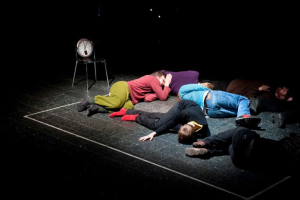
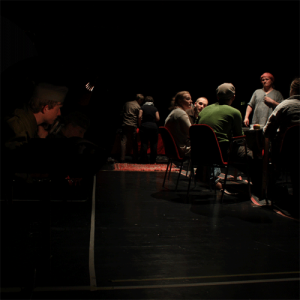
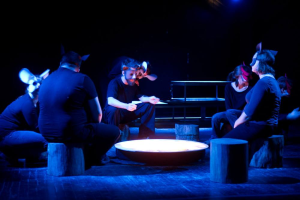
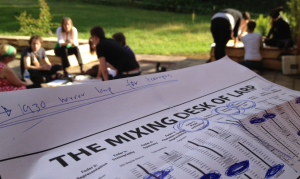
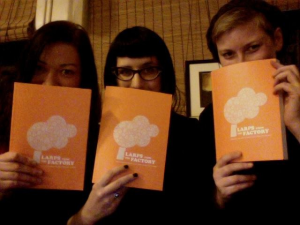
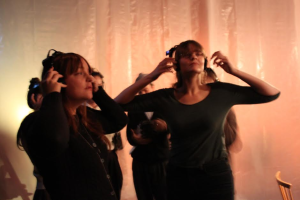
hard to accept the data presented in the table, mostly due to many mistakes the author (somehow) managed to make. First of all plently of standalone LARPs were activly using light and sound From 2005. I will even not mention some technical devices and abilities brought to us by computer technogy improvments. What i see currently in modern LARPs is some kind of (de)evolution directly linked to the resignation from choreography and scenography. Those limits, according to my observations, come from laziness of modern LARP creators. Commercialisation has some influence too. BTW It`s quite similar with the theatre branch.
Personally i live in Poland historically and up to this day country full of all styles and modes and what i see is horrible. Modern LARPs are more and more limited just due to north influence. I will even risk a statment that right now standard LARP cover less art/social/psychological areas then 4-5 years ago, moreover LARPs are less natural and harder for new ppl to play. U can try to justifie is with a polish trafition that imagination is usualy associated with simple RPG sessions instead of LARPs. What i see right now is a kind of the old style RPG session promoted somehow to the LARP with better prepered manuscript. ( what was also a minor school or style for leading the session).
MiW
Thank you for the comment. The idea behind the table is to describe some general tendencies of what is common in Nordic chamberlarp design. It should not be read as patterns that applies to ALL chamberlarps in 2010/2015.
Quite misleading information in that case is Nordic LARP term which last time is used quite worldwide i will say and actually “Nordic” LARPs are less played in Norway and Sweden than in other countries ( when we look for the total number of LARPs played) even when we see Nordic region as a flag of those LARP type.
I received the link for this page with some article with the note that it is about worldwide LARPs in general as the Knudepunkt is in the theory about worldwide larping.
PS. Next reason to unify terminology 😉